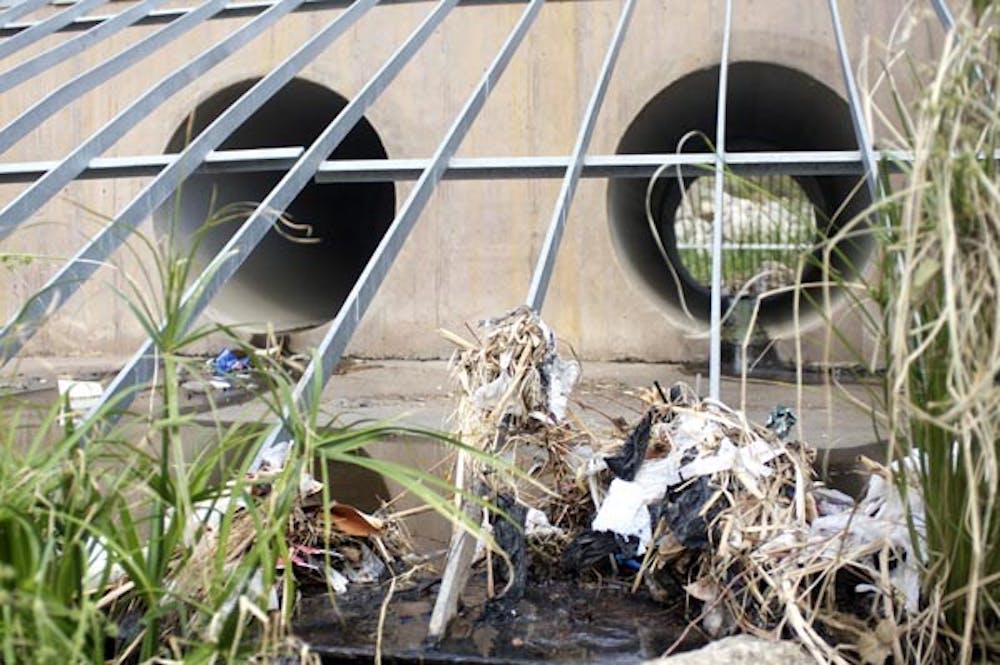A student project to re-engineer the Rio Salado Habitat Restoration Area drainage system might save the city of Phoenix hundreds of thousands of dollars a year in maintenance costs.
Students working with Engineering Projects in Community Service, known as EPICS, began designing a better system last year to prevent flooding when trash clogs grates that drain into the riverbed. The students have had to redesign their plans several times, but believe they are finally approaching a solution, said chemical engineering sophomore Jared Schoepf, an EPICS team leader.
“EPICS is such a new class that when we were given the project … we thought it was going to be really easy, and we thought we would be on to the next [project] by now,” said Brian Ivey, a civil engineering junior.
Most of the problems early on came when the team underestimated the level of water that flows through the drainage system of the Rio Salado Habitat.
The two EPICS teams headed by Schoepf and Alan Gillespie, a mechanical engineering senior, are working to create a better trash filtration system.
During a storm, water draining into the Rio Salado Habitat can flow through a 5-foot-wide pipe at a rate that can reach up to 94,000 gallons per minute, Gillespie said.
The high levels of water that flow to the habitat carry large amounts of trash that the current system can’t handle.
In 2000, Phoenix spent $100 million building the Rio Salado Habitat two miles south of Chase Field. The restoration project was fully completed in 2009. It returned five miles of river to its original state and provided a recreation area for the community, he said.
The habitat lies in the bed of the Salt River. Most of the water from the Salt River has been diverted for domestic use and agriculture. About 90 percent of the original river habitat was destroyed, Schoepf said.
The city maintains the site, paying seven park rangers to remove trash and mud from the pipes by hand, he said.
During a storm on Oct. 5, members of the team were able to observe the drainage system in action, Gillespie said.
They watched as the water rushed through the canals, which carry run-off from roads in Phoenix to the habitat. This water leaves dirt and trash caked almost all the way up a seven-foot-high grate meant to filter debris, he said.
The water runs through pipes underneath a road where a single metal grate lies at the mouth of the pipes, he said.
The massive water flows broke the bolts on the single metal grates, Gillespie said.
In addition, the mud and trash piled onto the grate — a large metal piece with slats through it. When it gets clogged, water can’t flow through the underpasses, which causes flooding.
The water “washes out the bridge to the point where you can see the concrete pipes,” Gillespie said.
Once a storm passes through, trash is left behind for up to five months, harming the natural state of the habitat and potentially the wildlife, team members said.
They are currently working on two of the sites with the most flooding. One canal has a diameter of seven feet and one has a diameter of five feet, Ivey said. The teams will also re-engineer nine other problem storm drains.
They plan to replace at least one of the current grates with an upright grate set away from the bridge, Ivey said.
This grate would include a second piece across the top, slightly tilted, to prevent trash from washing farther downstream. With their new design, the trash would hit the grate and be captured, he said.
The water would then flow over the trash and back into the pipe instead of being forced over the road, team members said.
The new design would include a road running down into the ditch to allow tractors to clean out the trash instead of workers cleaning it out by hand, they said.
Last year, they received several grants to help fund their research and designs, including the ASU Entrepreneur Advantage Project grant and the ASU Innovation Challenge grant. The grants totaled $9,000.
In order for their design to be installed, it must be approved by the U.S. Army Corps of Engineers because the habitat is technically part of the Salt River. The Army Corps of Engineers is responsible for managing public water resources.
The city of Phoenix must also approve the design since it will pay for the installation of the grates.
The EPICS team hopes to have their designs approved by the end of the semester, but they have yet to receive approval from any agency, and they might be asked to redesign the system again.
Reach the reporter at mary.shinn@asu.edu





